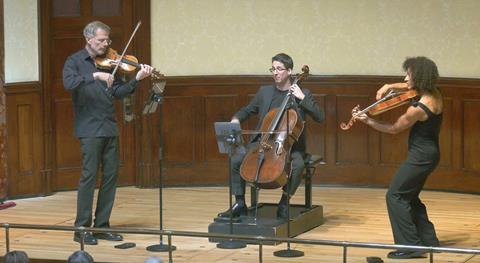Tim Homfray hears the performance of at London’s Wigmore Hall on 21 July 2024

Before starting Dmitry Sitkovetsky’s string trio arrangement of Bach’s Goldberg Variations, the members of the Scottish Ensemble helpfully explained how they worked: cellist Nathaniel Boyd played the bass-line, and violinist Jonathan Morton with violist Jane Atkins demonstrated canons.
The opening Aria was given with no vibrato and prominent cello. The musicians sounded crisp and dynamic in the first variation, and light in the second. Morton rearranged the arrangement of the first canon by playing the second half up an octave, which is where Bach originally put it. They were judicious in their choices of character and what dynamics to adopt (Bach and Sitkovetsky give none): the second canon was legato and gentle, the third stately and graceful.
The 10th-variation Fughetta was steady, the notes separated and pointed, and the players caressed the scurrying triplets of the 11th, actually a duet though split between the three of them. They clipped through the triplets of no.20 at a rapid pace, with neat voice-passing. Morton produced fine double-stopping in the four-part 22nd variation, and all three had fun with the hocketing of no.23. The Adagio Variation (no.25) was fluid and supple. Atkins opened the Quodlibet no.30 in robust fashion before a reverential repeat of the opening aria.
TIM HOMFRAY
Review: Rachel Podger: Bach: Goldberg Variations Reimagined
Review: Bach: Goldberg Variations (arr. Sitkovetsky)
Review: Jorge Jiménez: Rethinking Bach



































No comments yet